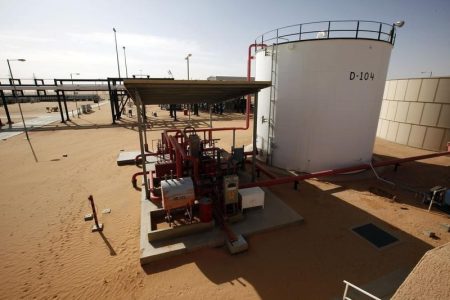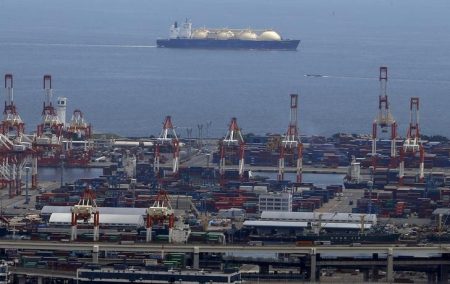Investing.com – Crude prices were up 4% Monday as the latest Middle East crisis reintroduced geopolitical risk into the oil trade in a way unseen in years, resetting markets that just days ago were depressed more by concerns over the global economy.
With an hour to settlement, New York-traded West Texas Intermediate, or , crude for delivery in November settled up $3.59, or 4.3%, at $86.38 per barrel. The US crude benchmark rose to as high as $87.23 earlier.
London-traded for the most-active December contract settled up $3.57, or 4.2%, at $88.15. The session high was $89 — just a dollar short of bringing the global crude benchmark back to the key bullish mark of $90 per barrel.
As Hamas rockets continued to rain on Israel’s largest city, Tel Aviv, and Prime Minister Benjamin Netanyahu vowed to “change the Middle East” with Israel’s war against the Palestine militant group, oil traders tried to ascertain the immediate impact of the crisis on oil supply from Iran.
Tehran is not only the world’s fifth largest crude exporter but also a vociferous supporter of the Palestine cause — and often initiator of Middle East conflagration.
Iran is tacitly known to be behind Hamas at all times. To reinforce that notion, an adviser to Iranian Supreme Leader Ali Khamenei said Tehran supported the operation against Israel that had reportedly killed some 1,300 people at the time of writing, and led to the abduction of dozens of Israelis by ground forces of the militant group.
“We congratulate the Palestinian fighters for this operation,” Yahya Rahim Safavi said, adding that Iran would stand by the Hamas fighters until they had “liberated” Palestinian territories and Jerusalem from Israeli control.
Nasser Kanaani, spokesman for the Iranian Foreign Ministry, also said the Hamas operation had “turned a new page” in the fight against Israel.
Without loss of Iranian barrels, oil might not rise too much from this crisis
John Kilduff, a partner at New York energy hedge fund Again Capital, who has spent two decades analyzing the impact of Middle East geopolitical strife on oil, likened the crisis to the “reset” sought by bulls hoping for a game changer in crude, after a woeful start to October trading.
“While there’s a huge immediate shock value, as well as durability and elasticity, in this crisis, what will matter in the end is the actual impact on oil supply, not implied,” Kilduff said. “Are the Iranians without doubt the sponsors of this attack, and if so, will the war vowed by Israel end up severely debilitating Iran’s oil shipments?”
“Also, will the US, after a long period of scant sanctions enforcement against Tehran’s oil, double down as well? If these things don’t happen the oil price could come back down.”
Vivek Dhar, analyst at Commonwealth Bank of Australia (OTC:), had a similar view, saying:
“For this conflict to have a lasting and meaningful impact on oil markets, there must be a sustained reduction in oil supply or transport. If Western countries officially link Iranian intelligence to the Hamas attack, then Iran’s oil supply and exports face imminent downside risks.”
With the Israelis vowing commensurate response for one of the worst attacks ever on their soil, a counter engagement against Tehran, either unilaterally by Jerusalem, or with the combined might of the United States, could have ramifications for the oil trade.
“Even if Israel doesn’t immediately respond to Iran, the repercussions will likely affect Iranian oil production,” Bloomberg oil columnist Javier Blas wrote. “Since late 2022, Washington has turned a blind eye to surging Iranian oil exports, bypassing American sanctions. The priority in Washington was an informal détente with Tehran.”
“As a result, Iranian oil output has surged nearly 700,000 barrels a day this year – the second-largest source of incremental supply in 2023, behind only US shale. The White House is now likely to enforce the sanctions.”
As of Monday, production cuts by the global group of oil producers known as OPEC+ looked set to continue as well, with no change indicated by Saudi Energy Minister Abdulaziz bin Salman.
The Saudis and Russians, who jointly lead the OPEC+, are withholding a daily supply of 1.3 million barrels between them, while the rest of the 23-nation alliance is contributing to a squeeze of another 2 million barrels or more.
“I honestly believe that the best thing I could say is that the cohesion of OPEC+ should not be challenged. We’ve been through the worst, I don’t think we will have to go through any terrible situation at all,” Abdulaziz, the Saudi energy minister, said on the sidelines of a climate conference in Riyadh.
“Yes, we may be delayed with a decision on what to do, but I would not forfeit the precautionary approach, even if it goes beyond a month or two, or three or four months, or five months,” he added.
Early last week, oil hit more than one-year highs of $95 for WTI and $97 for Brent, responding to the aggressive OPEC+ cuts.
From there, the market tumbled on a backdrop of macro and economic factors as US Treasury yields hit 16-year highs and the dollar soared to a 10-month peak while consumption of gasoline — the No. 1 fuel product in the United States — hit a seasonal low of 25 years. Specifically, US crude fell 9% last week and Brent 11%, the biggest weekly slump since March. It was a selloff deeper than any weekly rally in oil over the past three months.
“(That) this conflict could widen and drag in the West means the risk of future sanctions against Iran are growing,” said Ed Moya, analyst at online trading platform OANDA. “This is not going to be a quick war between Israel and Hamas, which means we could see oil behave more like a safe-haven if the geopolitical landscape deteriorates.”
“The oil market will remain volatile as potential supply disruptions will also need to counter falling global travel demand.”
(Peter Nurse contributed to this article)
Read the full article here















